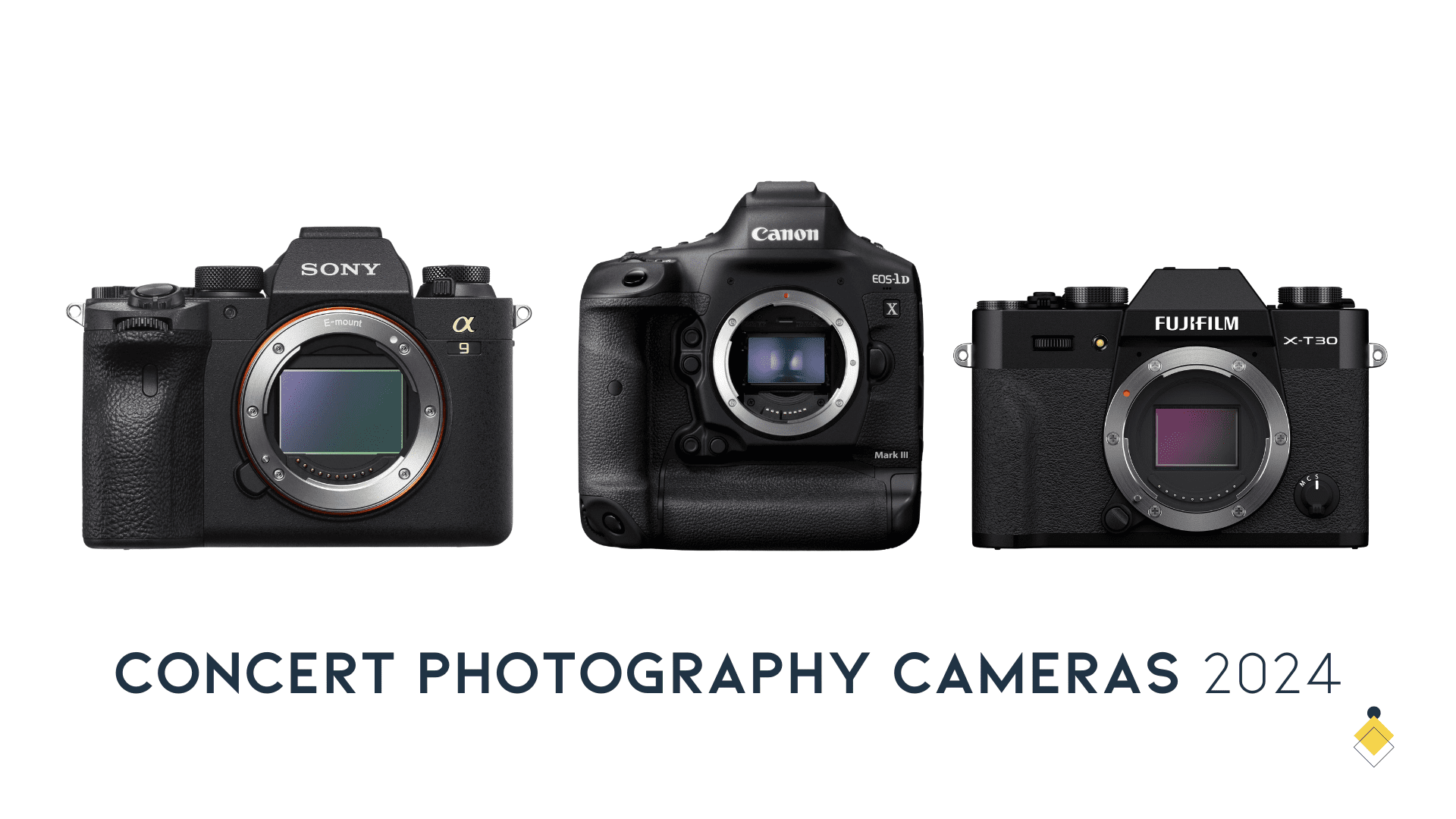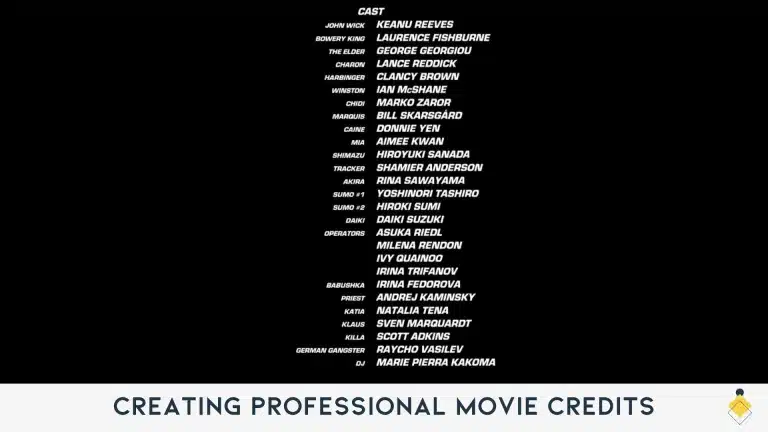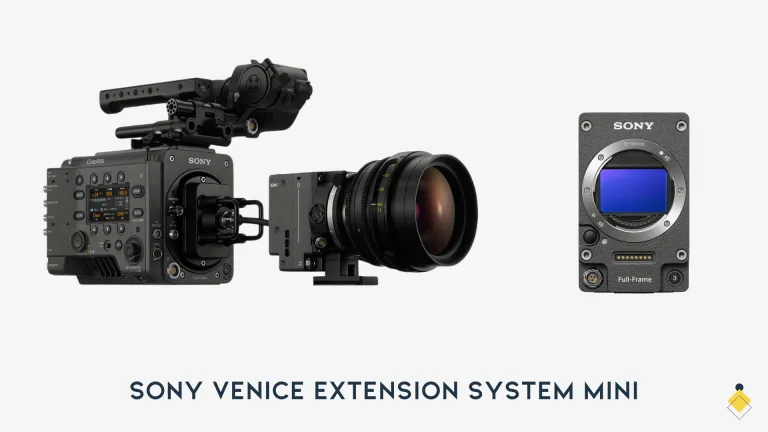Concert photography is a dynamic and challenging genre that demands precision, low-light capabilities, and quick autofocus.
To capture the electrifying energy of live performances, photographers need the best concert photography camera.
In this article, we’ll explore 13 top-notch cameras renowned for their prowess in concert photography, each with unique features that cater to the specific demands of this vibrant field.
Let’s dive into it!
What makes a camera great for concert photography?
Concert photography presents a unique set of challenges that demand specific features in a camera.
To ensure you capture the essence of live performances, your chosen camera must possess certain characteristics that enhance your ability to navigate the low-light environments, fast movements, and dynamic atmospheres of concerts.
Sensor Performance and Low-Light Capabilities
The camera’s sensor size and its low-light performance are crucial factors in concert photography.
A larger sensor, such as a full-frame sensor, provides better light-gathering capabilities and reduces noise in dimly lit venues. Look for cameras with high ISO sensitivity ranges to maintain image quality even in challenging lighting conditions.
Autofocus System
Concerts are fast-paced events where performers are constantly moving. An advanced autofocus system is essential for tracking moving subjects accurately.
Cameras with numerous autofocus points and sophisticated tracking algorithms ensure that you can lock onto your subject swiftly and maintain focus, capturing sharp images amid the action.
Burst Shooting Speed
The ability to capture rapid sequences of shots is invaluable for concert photography. Cameras with high burst shooting speeds, measured in frames per second (fps), allow you to freeze fleeting moments and select the perfect frame from a sequence.
This feature is particularly important for capturing dynamic stage performances.
Image Stabilization
Live events often mean shooting handheld, and concert venues can be dimly lit. In-body or lens-based image stabilization compensates for camera shake, resulting in sharper images without the need for a tripod.
This feature is especially useful when using longer focal lengths or slower shutter speeds.
ISO Performance
Concerts frequently involve dramatic shifts in lighting, from intense spotlights to moody atmospheres.
A camera’s ISO performance determines how well it can handle these changes while maintaining image quality. Cameras with high native ISO ranges and minimal noise at higher ISO settings excel in concert photography.
Durability and Build Quality
Concert environments can be chaotic, with crowded audiences and potential accidental knocks.
Cameras with rugged build quality and weather sealing ensure your gear can withstand the rigors of live events. A sturdy build also provides peace of mind when navigating through crowded venues.
Versatility
While concert photography is the primary focus, consider cameras with versatile features for broader creative possibilities. Some models offer advanced video capabilities, allowing you to capture both stills and high-quality footage. Such versatility caters to the demands of modern content creation.
Selecting the best concert photography camera goes beyond technical specifications. It’s about finding the right balance of features that cater to the unique challenges of live performances.
A camera with a robust sensor, advanced autofocus, fast burst shooting, image stabilization, impressive ISO performance, durability, and versatility will empower you to capture the vibrant energy and unforgettable moments that define concert photography.
13 Best concert photography cameras
Now let’s go ahead and see what are the best cameras for concert photography!
Nikon D6

The Nikon D6 reigns supreme as the pinnacle of Nikon’s DSLR lineup, embodying a no-compromise approach to speed, reliability, performance, and precision.
This exceptional camera seamlessly spans the realms of photography and videography, anchored by a 20.8MP FX-format sensor and powered by the EXPEED 6 image processor.
This powerhouse combination bestows upon the D6 a remarkable 14 fps continuous shooting rate, an ISO sensitivity range from 100 to 102400 and the ability to record UHD 4K videos at 30 fps.
Three Key Features for Concert Photography:
- High-Speed Continuous Shooting:
- Rapid 14 fps continuous shooting rate captures fast-paced concert action.
- Ensures no critical moment is missed, ideal for dynamic stage performances.
- Advanced Autofocus System:
- Multi-CAM 37K autofocus system with 105 cross-type points delivers precision and speed.
- Achieve sharp focus even in low light, critical for capturing artists in motion.
- Wide ISO Range and Low-Light Performance:
- Native ISO range from 100 to 102400, expandable to ISO 3280000.
- Exceptional low-light performance allows for noise-free images in challenging concert lighting.
The Nikon D6 stands as the ultimate companion for concert photographers, combining unmatched speed, precise focus, and low-light prowess to capture the electrifying energy and emotion of live performances.
Its robust build, advanced features, and unwavering reliability make it an indispensable tool for professionals dedicated to preserving the magic of live music experiences.
Canon EOS-1D X Mark III
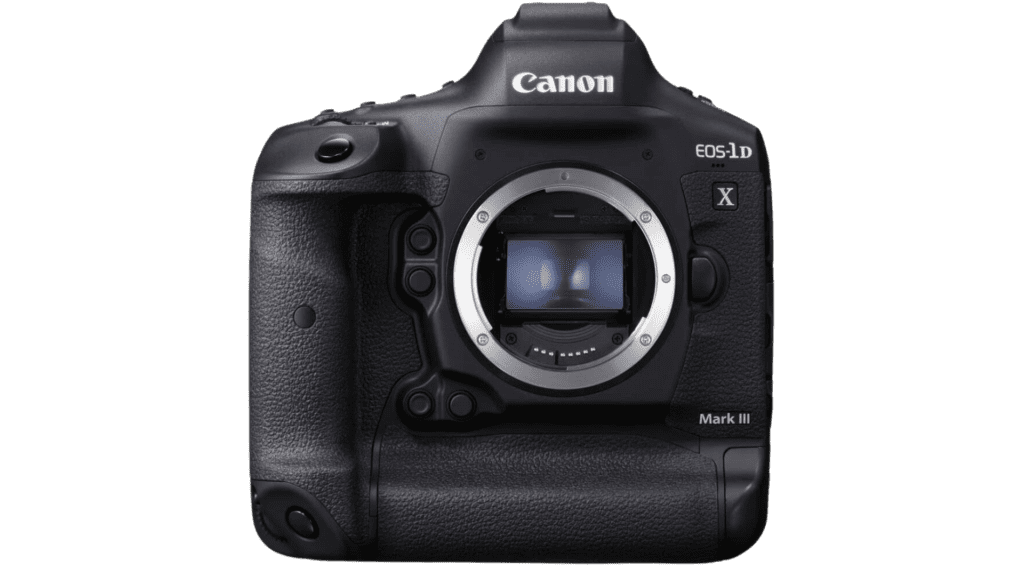
The Canon EOS-1D X Mark III epitomizes speed, sensitivity, and precision, making it a formidable DSLR tailored for demanding pursuits like sports, wildlife, and dynamic imaging scenarios.
Serving as the flagship of the EOS system, the 1D X Mark III is characterized by its refined processing capabilities and unparalleled speed, adeptly catering to both photography and videography.
Its newly crafted 20.1MP full-frame CMOS sensor, in conjunction with the updated DIGIC X image processor, empowers the camera to achieve continuous shooting rates of up to 16 fps through the optical viewfinder and a remarkable 20 fps in live view mode.
Moreover, it boasts a buffer capacity for raw+JPEG bursts of up to 1000 frames. This remarkable speed is complemented by a native sensitivity range from ISO 100-102400 ensuring optimal performance under varied lighting conditions.
Key Features for Concert Photography:
- High-Speed Continuous Shooting:
- An unparalleled 16 fps continuous shooting rate via the optical viewfinder captures fleeting concert moments with precision.
- Ensures every emotive expression and fleeting gesture is vividly captured for posterity.
- Advanced Autofocus System:
- Equipped with the EOS iTR AF X autofocus system, featuring 191 points for rapid and precise subject acquisition.
- Deep Learning Technology-enabled Face Tracking and Head Detection AF maintain essential focus on subjects in motion.
- Exceptional Low-Light Performance:
- Wide ISO range from 100-102400, expandable to 50-819200, excels in challenging concert lighting conditions.
- Ensures image quality remains uncompromised, with reduced noise even in dimly lit concert venues.
The Canon EOS-1D X Mark III elevates concert photography, effortlessly merging unrivaled speed, precise autofocus, and extraordinary low-light performance to immortalize the energy and emotion of live performances.
Its robust construction, advanced features, and exceptional reliability establish it as an indispensable tool for professionals striving to capture the enchantment of musical experiences.
Sony A9 II
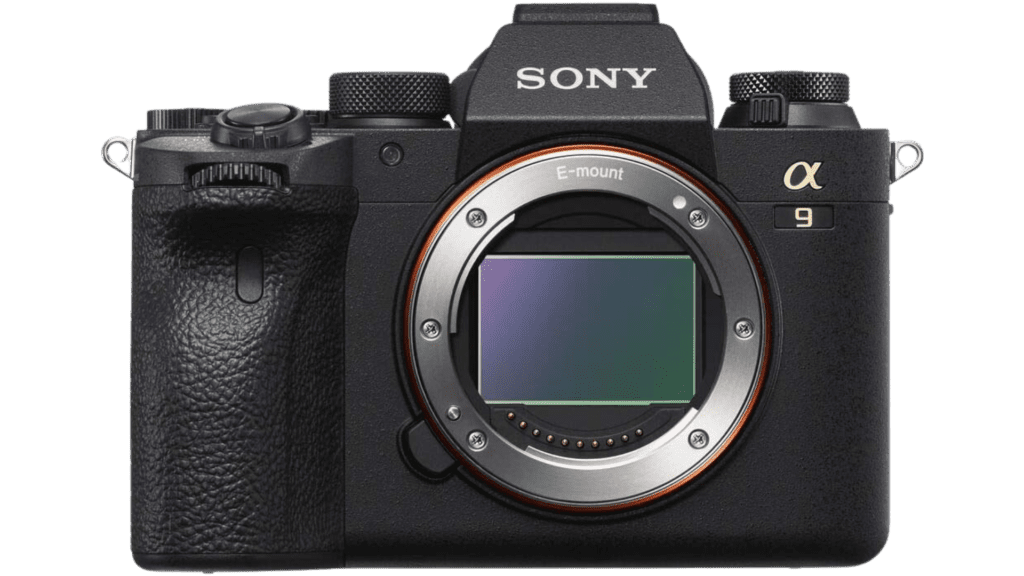
The Sony a9 II builds upon the impressive foundation of its predecessor, elevating it with enhanced connectivity, refined body design, and even swifter performance.
Utilizing the proven 24.2MP full-frame Exmor RS BSI stacked CMOS sensor and an updated BIONZ X processor, the a9 II demonstrates remarkable speed and responsiveness.
Its updated construction showcases a more ergonomic shape, improved weather sealing, and enhanced connectivity and transfer speeds.
Key Features for Concert Photography:
- High-Speed Shooting Performance:
- Utilizes a 24.2MP Exmor RS BSI stacked CMOS sensor and updated BIONZ X processor for rapid and responsive shooting.
- Offers an astounding 20 fps continuous shooting with the electronic shutter and 10 fps with the mechanical shutter, capturing fleeting concert moments with precision.
- Advanced Autofocus and Image Stabilization:
- Incorporates a Fast Hybrid AF system with 693 phase-detection points and 425 contrast-detection areas for precise focusing even in challenging lighting conditions.
- 5-axis SteadyShot INSIDE image stabilization compensates for various types of camera shake, ensuring clear, blur-free images while capturing the energy of live performances.
- Enhanced EVF and Connectivity:
- Features a Quad-VGA OLED Tru-Finder EVF with a 3.69m-dot resolution and 0.78x magnification for bright, detailed viewing.
- Built-in Wi-Fi, Bluetooth, and Ethernet connectivity enable seamless sharing, wireless tethering, and efficient remote operation, allowing concert photographers to stay connected and in control.
The Sony a9 II combines rapid shooting capabilities, precise autofocus, and advanced image stabilization to capture the essence of live concerts.
Fujifilm X-T5
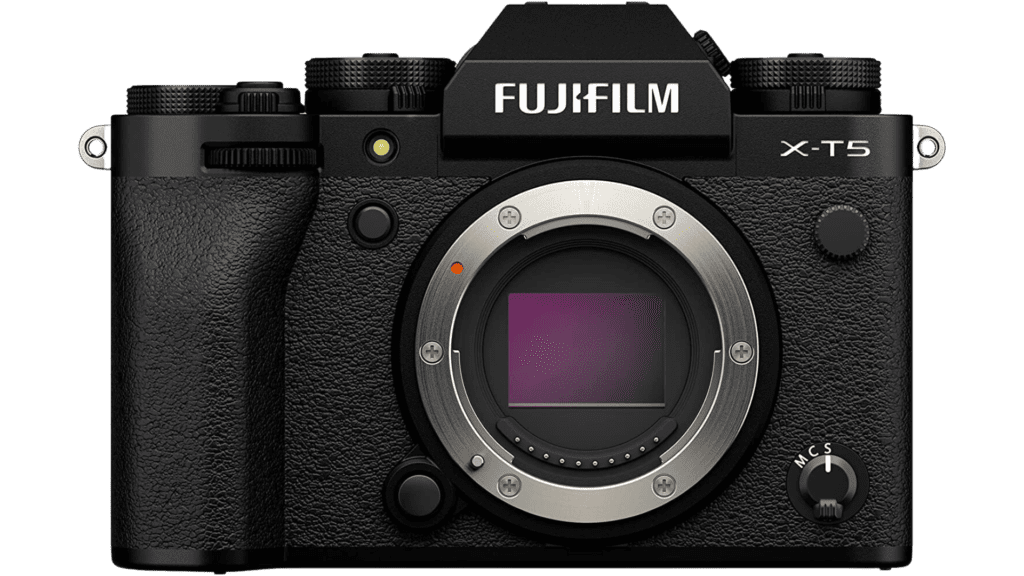
The FUJIFILM X-T5 is a portable and powerful mirrorless camera designed for multimedia enthusiasts seeking exceptional results.
Featuring the newly developed 40MP APS-C X-Trans CMOS 5 HR BSI sensor, this camera delivers stunning imagery.
Compact yet robust, it embodies a classic dial-based layout coupled with cutting-edge technology. The X-T5 boasts a seven-stop in-body image stabilization system, Pixel Shift Multi-Shot mode for 160MP files, and an electronic shutter with action-freezing speeds up to 1/180,000 sec.
Beyond stills, its video capabilities shine, recording up to 6.2K in 4:2:2 10-bit color internally or 12-bit ProRes RAW and Blackmagic RAW via HDMI.
Key Features for Concert Photography:
- 40MP APS-C X-Trans CMOS 5 HR BSI Sensor:
- Compact and lightweight body houses a 40MP X-Trans 5 HR CMOS sensor, delivering unparalleled image quality across the ISO range.
- Improved image processing algorithm ensures outstanding detail and performance, enabling you to capture the essence of concerts in remarkable clarity.
- Powerful Video Capabilities:
- Record internally up to 6.2K at 30p in 4:2:2 10-bit color.
- 4K HQ mode oversamples 6.2K footage for superior 4K output, unlocking 2x digital zoom for added versatility without compromising quality.
- Output F-Log, F-Log2, 12-bit ProRes RAW, and Blackmagic RAW via HDMI for comprehensive video recording options.
- 425-Point Intelligent Hybrid AF System:
- Utilizes 425 phase-detection points and achieves sensitivity down to -7 EV, ensuring accurate autofocus even in low-light conditions.
- AI adaptive algorithm enhances subject detection and tracking for moving subjects, making it suitable for capturing dynamic concert moments.
The FUJIFILM X-T5 combines exceptional image quality, powerful video capabilities, and advanced autofocus to bring your concert photography to life.
With its compact design, innovative features, and versatile performance, it’s a reliable tool for capturing the energy, emotions, and fast-paced action of live performances.
Nikon Z6 II

The Nikon Z6 II represents an evolution of excellence, offering enhanced speed, versatility, and performance for discerning multimedia creators.
This mirrorless camera is designed to cater to the demands of high-end photo and video applications while maintaining its iconic form factor and renowned image quality.
With a 24.5MP FX-Format BSI CMOS sensor, Dual EXPEED 6 Processors, and a host of advanced features, the Z6 II empowers multimedia image-makers to excel in their craft.
Key Features for Concert Photography:
- 24.5MP FX-Format BSI CMOS Sensor and Dual EXPEED 6 Processors:
- Capture exceptional images with a 24.5MP BSI CMOS sensor that excels in low-light conditions and delivers swift readout speeds for continuous shooting and time-lapse recording.
- Dual EXPEED 6 processors enhance speed and performance throughout the camera system, supporting continuous shooting at 14 fps for up to 124 frames.
- UHD 4K Video Recording:
- Unlock your video creativity with UHD 4K video recording at up to 30p, leveraging full pixel readout for outstanding clarity.
- Record Full HD 1080p video at up to 120p for captivating slow-motion effects.
- Benefit from advanced video features, including N-Log gamma for expanded dynamic range, HLG (HDR) for HDR-ready footage, and 10-bit data output over HDMI.
- 273-Point Phase-Detect AF System & Vibration Reduction:
- Enjoy rapid and precise autofocus with 273 phase-detect points covering 90% of the image area.
- Hybrid AF seamlessly transitions between phase- and contrast-detect systems for smooth focus during video recording.
- In-body 5-axis sensor-shift Vibration Reduction compensates for up to 5 stops of camera shake, ensuring sharp and stable shots, especially crucial for concert photography.
The Nikon Z6 II is an exceptional tool for capturing the essence of live concerts. Its impeccable image quality, impressive video capabilities, and reliable autofocus make it a versatile companion for multimedia creators.
Canon EOS R5
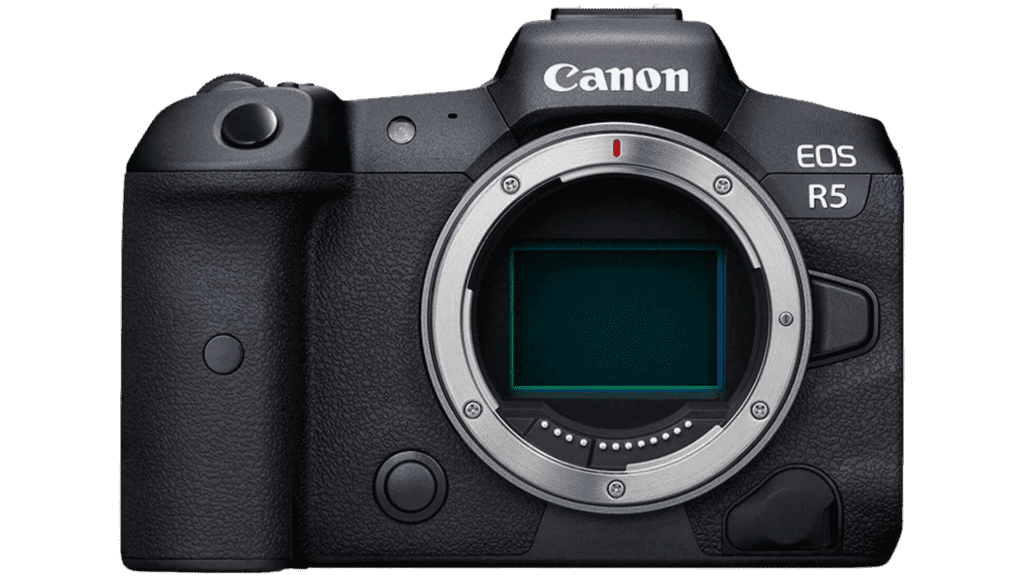
The Canon EOS R5 is a full-frame mirrorless camera that caters to the needs of professional image-makers demanding exceptional resolution, speed, and video capabilities.
Packed with cutting-edge technology, this camera houses a newly developed 45MP CMOS sensor, enabling remarkable 8K raw video recording, swift 12 fps continuous shooting with a mechanical shutter, and groundbreaking 5-axis sensor-shift image stabilization.
The EOS R5 embodies the essence of creativity and performance, delivering unrivaled results for both photography and videography.
Key Features for Concert Photography:
- 45MP Full-Frame Sensor and DIGIC X Processor:
- Equipped with a groundbreaking 45MP CMOS sensor and DIGIC X image processor, the EOS R5 offers exceptional stills and video output.
- A sensitivity range of ISO 100-51200 (expandable to ISO 102400) suits diverse lighting conditions, while continuous shooting up to 12 fps (mechanical shutter) or silent 20 fps (electronic shutter) captures fleeting moments.
- 8K30 Raw and 4K120 Video Recording:
- Experience the future of video with DCI 8K 30 fps raw video recording and 4K recording up to 120 fps in 4:2:2 10-bit with Canon Log.
- HDR-PQ recording, in-camera HDR production, and clean 4K output up to 60 fps via HDMI elevate your video capabilities.
- Firmware update 1.4.0 allows 8K30 ProRes raw recording to Atomos Ninja V+ recorder through HDMI.
- Dual Pixel CMOS AF II with Deep Learning Technology:
- The Dual Pixel CMOS AF II boasts 1053 selectable focusing points covering nearly 100% of the image frame for seamless and rapid focusing.
- Deep Learning technology enhances subject tracking, eye, face, and head-detection, offering precise focus for both people and animals.
- Enjoy smooth and natural focus transitions in Movie Servo AF mode, benefiting video recording and dynamic scenes.
The Canon EOS R5 sets a new benchmark for professional mirrorless cameras, making it an ideal choice for capturing the energy and essence of live concerts.
Sony A7 III
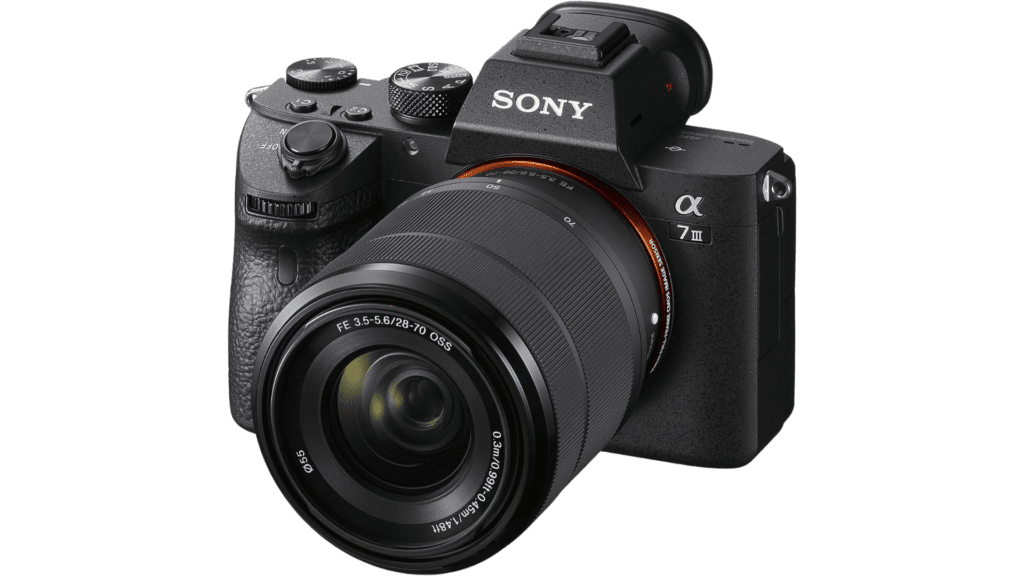
The Sony a7 III stands as a versatile and well-balanced camera that caters to the needs of both photography and videography enthusiasts across various scenarios.
Boasting a new 24.2MP Exmor R BSI CMOS sensor and BIONZ X processor, this camera delivers exceptional image quality, improved low-light performance, and remarkable autofocus capabilities.
The a7 III features a refined body design with a host of enhancements, including a responsive touchscreen LCD, upgraded EVF, extended battery life, and dual memory card slots.
Key Features for Concert Photography:
- Full-Frame BSI Sensor and BIONZ X Processor:
- Equipped with a back-illuminated 24.2MP Exmor R CMOS sensor and BIONZ X image processor, the a7 III delivers high-resolution imagery and improved noise reduction.
- The sensor offers a native sensitivity range of ISO 100-51200 (expandable to ISO 50-204800), supporting clear images even in challenging lighting conditions.
- Experience remarkable internal UHD 4K video recording with a wide dynamic range using the full width of the full-frame sensor.
- UHD 4K Video Recording in XAVC S Format:
- Capture UHD 4K videos in various frame rates up to 30 fps with 2.4x oversampling for enhanced detail.
- Full pixel readout ensures superior quality with reduced moiré and aliasing, while full HD 1080p recording at up to 120 fps facilitates smooth slow-motion playback.
- Uncompressed HDMI output enables clean 4K recording with 4:2:2 sampling when using an external recorder.
- 5-Axis SteadyShot INSIDE Image Stabilization:
- The robust a7 III features a 5-stop 5-axis SteadyShot INSIDE image stabilization system that compensates for various types of camera shake during handheld shooting.
- Corrects for pitch, yaw adjustments, horizontal and vertical shifts, and roll compensation, ensuring sharp and stable images even with non-stabilized lenses or adapted lenses.
With its blend of exceptional imaging capabilities, 4K video prowess, and reliable autofocus performance, the Sony a7 III proves to be a top choice for capturing captivating concert moments.
Panasonic Lumix GH5 II
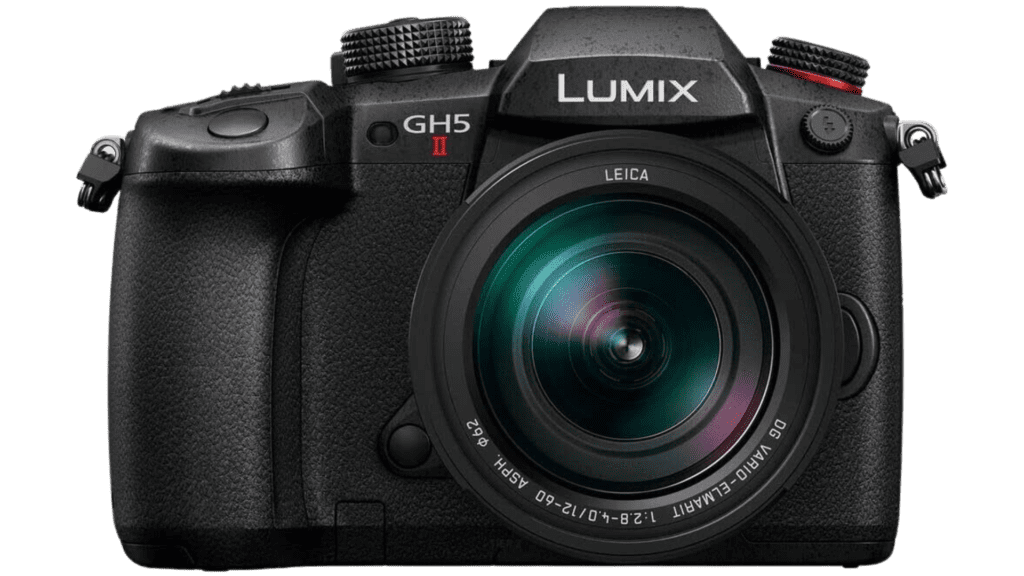
The Panasonic Lumix GH5 II is a remarkable mirrorless camera designed to meet the diverse needs of both videographers and photographers seeking exceptional quality in a compact form factor.
This camera combines advanced video capabilities with impressive stills performance, making it a versatile choice for creative professionals. With a 20.3MP Live MOS sensor featuring an AR coating and powerful Venus Engine Imaging Processor, the GH5 II excels in both imaging and video recording.
Key Features for Concert Photography:
- Professional Video Performance:
- The GH5 II is equipped with updated video capabilities, supporting DCI and UHD 4K recording with the entire sensor area.
- Internal recording up to 60p in 10-bit 4:2:0 or 30p in 4:2:2 ensures high-quality video output for post-production.
- Included V-Log L preset facilitates consistent color grading when used in conjunction with other VariCam-series cameras.
- 5-Axis Dual I.S. 2 Stabilization:
- Enhanced 5-axis sensor stabilization system, combined with Lumix O.I.S lenses, activates Dual I.S. 2 for up to 6.5 stops of effective shake correction.
- Shake compensation is optimized for various types of movement, resulting in sharper, clearer imagery in handheld shooting situations.
- Depth-from-Defocus Autofocus System:
- Incorporating advanced deep learning technology, the GH5 II’s autofocus system recognizes specific subjects, including humans and fast-moving animals.
- Improved tracking performance swiftly identifies faces, eyes, and bodies of moving subjects, ensuring precise focus and composition.
- Depth-from-Defocus technology calculates spatial information instantaneously for accurate capture.
The Panasonic Lumix GH5 II is tailored to professionals seeking top-tier video and stills capabilities in a compact package.
Its powerful sensor, advanced stabilization, and refined autofocus make it an ideal tool for capturing dynamic moments in concert photography, allowing you to achieve outstanding results even in challenging lighting conditions.
Olympus OM-D E-M1 Mark III

The Olympus OM-D E-M1 Mark III is a versatile Micro Four Thirds mirrorless camera designed to excel in various photographic scenarios.
With a focus on speed, portability, and image quality, this camera is well-suited for both stills and video applications.
Equipped with a 20.4MP Live MOS sensor and an updated TruePic IX image processor, the E-M1 Mark III delivers impressive continuous shooting capabilities, 4K video recording, and advanced autofocus performance.
Key Features for Concert Photography:
- High-Speed Performance:
- The E-M1 Mark III features a 20.4MP Live MOS sensor paired with the TruePic IX image processor for fast and efficient performance.
- It offers a full-resolution continuous shooting rate of 15 fps with the mechanical shutter and up to 60 fps with the electronic shutter for capturing fast-moving subjects like performers on stage.
- 5-Axis Sensor-Shift Image Stabilization:
- The advanced 5-axis sensor-shift image stabilization compensates for up to 7.5 stops of camera shake, enabling sharper handheld shots in low light conditions.
- This stabilization system is particularly useful when shooting concerts where stable handheld shooting is essential to capture dynamic moments without blur.
- 121-Point All Cross-Type Phase-Detection AF:
- The camera’s sophisticated autofocus system combines 121 on-chip phase-detection points and 121 contrast detection areas for accurate and quick focusing performance.
- The 121 cross-type phase-detection points enhance precision in various lighting conditions, ensuring reliable subject tracking even in challenging concert lighting setups.
The Olympus OM-D E-M1 Mark III offers concert photographers a powerful tool with its high-speed shooting capabilities, effective image stabilization, and advanced autofocus system.
Nikon D850

The Nikon D850 is a high-performance multimedia DSLR that seamlessly combines exceptional stills capabilities with impressive movie recording and time-lapse functionalities.
Anchored by a newly designed 45.7MP BSI CMOS sensor and the powerful EXPEED 5 image processor, the D850 stands out for its remarkable resolution, low-light proficiency, and rapid readout speed.
The sensor’s back-illuminated design excels in capturing intricate details even in challenging lighting, while forgoing the optical low-pass filter ensures enhanced sharpness. Partnering with the sensor is the EXPEED 5 processor, enabling a continuous shooting rate of 7 fps for up to 51 frames, an expandable ISO range from 32 to 102400, and 4K UHD video recording in either DX crop or full-frame mode.
Notably, an 8K time-lapse recording mode is also available, alongside specialized modes for digitizing film negatives and focus stacking.
Key Features for Concert Photography:
- High Resolution and Low-Light Performance:
- The D850 boasts a groundbreaking 45.7MP BSI CMOS sensor, delivering exceptional resolution and sharpness for capturing intricate concert moments in fine detail.
- The back-illuminated sensor design excels in low-light conditions, ensuring clean and detailed images even when shooting under challenging stage lighting.
- Multi-CAM 20K Autofocus System:
- The advanced Multi-CAM 20K 153-point AF system, previously seen in the flagship D5, features 99 cross-type sensors for precise subject recognition.
- With 15 points compatible with effective apertures of f/8, the D850’s AF system offers reliable focusing, even when using telephoto lenses or teleconverters, making it ideal for capturing performers in motion.
- 4K UHD Video Recording and 8K Time-Lapse:
- The D850 is equipped for versatile multimedia applications, including 4K UHD video recording in either full-frame or DX crop mode, allowing for diverse compositions and perspectives of concert performances.
- The camera’s ability to create 8K time-lapse recordings offers a creative way to capture the dynamic energy of live concerts, while also showcasing intricate details over time.
The Nikon D850’s remarkable combination of high resolution, advanced autofocus capabilities, and versatile multimedia functionalities makes it an excellent choice for concert photography.
Canon EOS 90D

The Canon EOS 90D stands as a versatile DSLR that combines advanced photo and video capabilities.
Anchored by a high-resolution 32.5MP APS-C CMOS sensor, the 90D delivers stunning image quality with enhanced clarity, dynamic range, and ISO sensitivity up to 25600.
Coupled with powerful image processing, this sensor can produce UHD 4K30p video and Full HD 120p video, as well as offer a continuous still shooting rate of up to 10 fps.
Key Features for Concert Photography:
- High-Resolution Sensor for Detail and Clarity:
- The 32.5MP APS-C CMOS sensor delivers outstanding image quality with remarkable clarity, dynamic range, and sensitivity.
- High-resolution imagery allows for capturing concert performances with intricate details, from the expressions of performers to the mood of the audience.
- Dual Pixel CMOS AF System:
- The Dual Pixel CMOS AF system provides fast, smooth, and accurate focusing during live-view shooting and video recording.
- It allows for natural and precise focus adjustments similar to a camcorder, enabling you to maintain a sharp focus on moving subjects and capture candid moments during concerts.
- Vari-Angle Touchscreen LCD and Optical Viewfinder:
- The 3.0″ vari-angle touchscreen LCD offers intuitive control and compositional freedom for shooting from various angles.
- The optical pentaprism viewfinder provides a bright and clear means of framing shots, adding to the immersive DSLR shooting experience.
The Canon EOS 90D’s blend of high-resolution imaging, advanced autofocus capabilities, and versatile shooting options make it an excellent choice for a beginner who wants to get into concert photography.
Sony A6600

The Sony a6600 stands as a versatile and powerful APS-C-format mirrorless camera designed to excel in both photography and videography.
Built to emphasize speed and versatility, this sleek camera boasts a refined 24.2MP CMOS sensor that delivers high-resolution images and supports up to UHD 4K video recording without time limits.
Key Features for Concert Photography:
- Fast Hybrid AF System:
- The 4D FOCUS system integrates 425 on-chip phase-detection points and 425 contrast-detection areas, achieving precise focusing in just 0.02 seconds.
- Real-time Tracking intelligently follows subjects, and Real-time Eye AF locks onto recognized subjects’ eyes, whether they are humans or animals, for sharp and accurate focus during both stills and video shooting.
- Lock-on AF maintains focus on moving subjects, and Expand Flexible Spot retains focus even if the initially selected point loses focus.
- Focus Magnifier and Touch Focus control provide precise focusing control for capturing critical moments during live performances.
- In-Body Image Stabilization (IBIS):
- The 5-axis SteadyShot INSIDE image stabilization compensates for various types of camera shake encountered during handheld shooting.
- Steady shooting is achievable with any lens, including adapted and third-party lenses, thanks to the stabilization system’s pitch, yaw, horizontal/vertical shift, and roll compensation.
- IBIS ensures sharp, blur-free images in concert environments, allowing you to use longer focal lengths or capture macro shots with confidence.
- UHD 4K Video Recording and Audio Control:
- UHD 4K video recording at up to 30p employs full pixel readout with 6K oversampling, resulting in detailed and moiré-free footage.
- Uncompressed HDMI output enables external recording with 4:2:2 sampling, and there is no recording time limit for movie recording, making it suitable for recording entire concert performances.
- Built-in 3.5mm headphone and microphone ports provide comprehensive audio control for producing high-quality concert videos.
The Sony a6600’s combination of swift and precise autofocus, in-body stabilization, and impressive video capabilities makes it an excellent choice for concert photography and videography.
Fujifilm X-T30
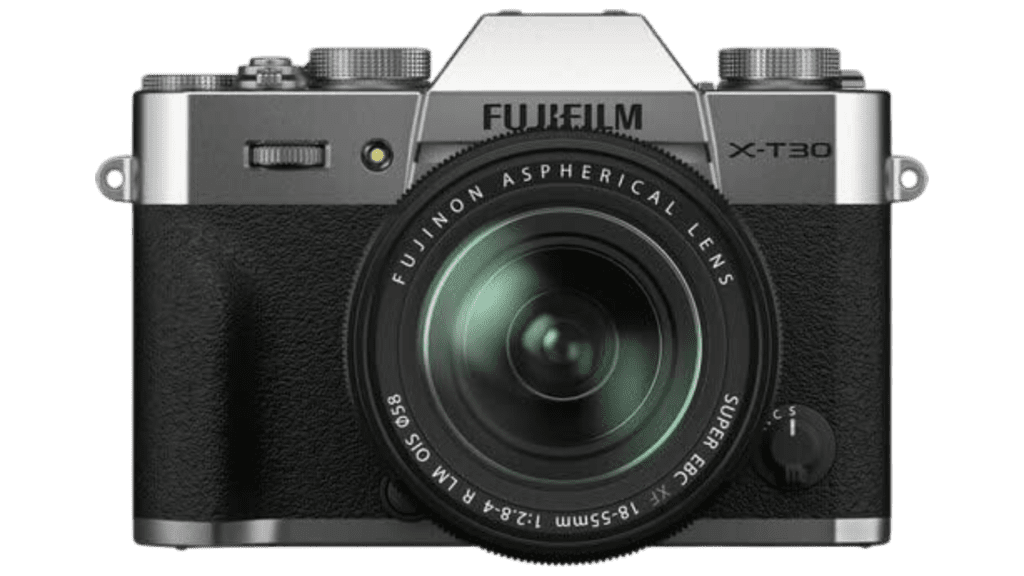
The FUJIFILM X-T30 II presents a versatile mirrorless camera that combines advanced imaging and video features with a sleek and intuitive design.
Designed for both stills and video recording, this camera boasts a revised image sensor and processor, offering high-resolution imagery and 4K video capabilities.
Key Features for Concert Photography:
- 26.1MP X-Trans CMOS 4 Sensor and X-Processor 4:
- Equipped with a 26.1MP APS-C X-Trans CMOS 4 sensor, featuring a back-illuminated design for improved low-light performance and a low native ISO 160 setting.
- The randomized pixel array reduces moiré and aliasing, enhancing image quality and sharpness.
- The sensor incorporates a 425-point phase-detection autofocus system, offering quick and accurate AF performance and subject tracking, even in challenging lighting conditions.
- X-Processor 4, with its quad-core CPU, provides faster image processing, enables continuous shooting up to 8 fps with a mechanical shutter, and supports internal DCI/UHD 4K30 video recording.
- UHD and DCI 4K Video Recording:
- Offers internal UHD 4K30 video recording at up to 200 Mb/s, along with DCI 4K30 and Full HD 1080p120 recording.
- High-speed quad-CPU X-Processor 4 minimizes rolling shutter distortion during 4K video recording, ensuring smoother motion capture.
- F-Log gamma setting provides a flat picture for advanced color grading during editing, with improved noise reduction in F-Log and extended minimum sensitivity down to ISO 640.
- Enhanced Autofocus and Face Selection:
- Intelligent Hybrid AF system achieves focus in as fast as 0.02 seconds, and now tracks moving subjects more effectively.
- 100% phase-detection AF coverage with 425 selectable points for precise and reliable focusing.
- Improved face and eye detection autofocus includes a Face Selection option for refined focusing control, ideal for capturing performers in concert environments.
The FUJIFILM X-T30 II showcases a retro-inspired design with tactile controls reminiscent of classic film cameras.
Its high-resolution OLED electronic viewfinder and tilting touchscreen LCD offer versatile shooting options.
Built-in Bluetooth facilitates wireless sharing and remote control, while the camera’s compact form factor makes it convenient for capturing dynamic concert moments.
Conclusion
Selecting the best concert photography camera involves considering various factors such as sensor size, autofocus capabilities, and burst shooting speed.
The Nikon D6, Canon EOS-1D X Mark III, Sony A9 II, and other cameras discussed here offer exceptional tools for capturing the energy and emotion of live performances.
With these top-tier options at your disposal, you’ll be well-equipped to document the electrifying moments that make concert photography a truly captivating art form.
Frequently Asked Questions
Concert photographers often use flash sparingly or avoid it altogether. Flash can be disruptive to performers and the audience, affecting the overall experience. Many concert venues also have restrictions on flash usage. Instead, photographers rely on high ISO settings, fast lenses, and skilled use of available stage lighting to capture dynamic shots in low-light conditions.
To secure concert photography gigs, you should:
– Build a strong portfolio: Showcase your best concert and music-related photos.
– Attend local shows: Start by photographing smaller gigs and local bands to gain experience.
– Network with musicians and industry professionals: Establish connections in the music scene.
– Create an online presence: Build a website or social media profiles to showcase your work.
– Reach out to event organizers: Contact venues, bands, and promoters to offer your services.
– Offer your work for free initially: Gain exposure and build relationships, then transition to paid gigs.
To become a concert photographer, you can:
– Learn photography basics: Understand concepts like exposure, composition, and camera settings.
– Invest in equipment: Acquire a DSLR or mirrorless camera with interchangeable lenses and fast lenses suitable for low-light conditions.
– Master low-light photography: Develop skills in shooting in challenging lighting environments.
– Build a portfolio: Capture live music events, festivals, and local shows to showcase your talent.
– Develop editing skills: Learn post-processing techniques to enhance your photos.
– Network and make connections: Connect with musicians, bands, event organizers, and other photographers in the industry.
– Promote your work: Create an online presence through a website or social media to showcase your portfolio.
– Pursue opportunities: Approach venues, bands, and promoters for potential photography gigs.
– Keep improving: Continuously refine your skills and adapt to new trends in photography and the music industry.
A camera designed for concert photography requires a camera that excels in low-light concert environments, possesses cameras with advanced autofocus capabilities, and offers fast continuous shooting. Features such as cameras with built-in image stabilization and a wide range of compatible lens options also contribute to making a camera perfect for concert photography.
The choice between a zoom lens and a prime lens depends on the demands of concert photography you’re faced with. A zoom lens offers flexibility in framing shots without changing your position, ideal for capturing a variety of compositions at different focal lengths and apertures. A prime lens, though fixed in focal length, tends to offer a wider maximum aperture, which is beneficial for shooting in the dim lighting conditions often encountered in concert venues.
The Nikon Z9 is considered an excellent camera for concert photography, thanks to its advanced features tailored to the needs of professional photography under challenging conditions. With its robust Z system, the Nikon Z9 offers exceptional low-light performance, high-resolution imaging, and fast continuous shooting speeds, making it perfect for capturing the dynamic and unpredictably lit environments of concerts.
The Sony Alpha series cameras are renowned for their impressive autofocus capabilities, high ISO performance, and compact form factor. These cameras are equipped with features that concert photography requires, like fast continuous shooting and excellent low-light performance, making them a favorite among concert photographers. Additionally, the Sony Alpha series offers a range of compatible lenses, including prime and zoom options, allowing photographers to capture breathtaking concert moments with clarity and detail.
Concert photographers should consider cameras with built-in image stabilization because it significantly reduces camera shake and blur in low shutter speeds. This is particularly crucial in low-light concert settings where lowering shutter speed can help achieve proper exposure without the need to excessively increase ISO. It enables photographers to capture sharper and clearer images under the challenging lighting conditions prevalent in concert photography.
While mirrorless cameras have gained popularity due to their compact size and advanced features, DSLRs remain relevant for concert photography in 2024, especially for photographers who foresee the need for the DSLR’s optical viewfinder, longer battery life, and the robust build quality. Nikon DSLRs and Canon R6 are examples that continue to be reliable choices for photographers who value these traditional advantages.
When using the Nikon Z system, concert photographers have a vast array of lens options, ranging from wide-angle lenses perfect for capturing the entire stage, to telephoto lenses ideal for close-up shots of artists. Nikon’s Z-mount system specifically accommodates a variety of zoom and prime lenses, including the popular 35mm prime for stunning portraits and the versatile 70-200mm zoom lens for comprehensive coverage. Nikon’s commitment to expanding the Nikon Z system ensures photographers have access to lens options that meet the dynamic needs of concert photography.
The choice of camera body significantly affects the results of concert photography. A camera body that excels in low-light conditions, possesses fast autofocus, and supports high ISO settings without compromising image quality is crucial. Additionally, camera bodies designed to accommodate a wide range of lens options—including both zoom and prime lenses—provide photographers with the flexibility to adapt to various shooting conditions encountered in concert photography. Hence, choosing the best camera body is as important as the lens used, as it forms the foundation for capturing the vibrant and often fleeting moments of a concert.

